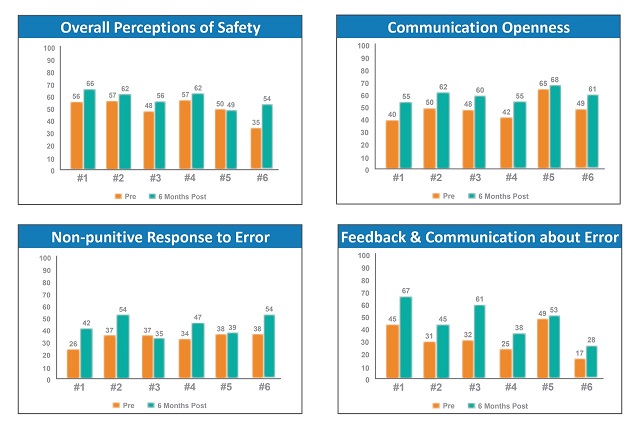The old cliché “patient safety is a dynamic non-event where you have to work hard for nothing to happen” is a powerful reminder of the work we still need to accomplish.
MEDNAX is committed to implementing a comprehensive HRO Patient Safety Initiative throughout all of its anesthesia practices and its hospital partners across the country. This initiative embraces the principles held by High Reliability Organizations (HROs). Our vision is to shape a reliability culture that creates safety and our mission is to train leaders to become HeROs, HRO leaders.

One of the most important points to be made about creating an HRO is the importance of establishing an organizational culture of safety. Whether the HRO is a commercial airline, aircraft carrier, or a nuclear power plant, these organizations prioritize safety by empowering every individual to accept a role in ensuring safety. Simply put, everyone on the team understands and acts on their obligation to recognize and report unsafe conditions and errors. The organization then acts rapidly to correct these problems and communicates the improvements.
The rationale for embracing high reliability theory in team care anesthesia grew from the awareness that anesthesia is similarly a team-based high risk occupation that requires high-level teamwork and communication. But, the success of cultural transformations within anesthesia practices is challenged by the often steep hierarchical authority and decision-making structure of most team care environments. Furthermore, the ability to communicate effectively is not always adequately developed because of individual practice complexities and priorities.

If individuals in a team care model are uncomfortable speaking up and questioning authority in the interest of patient safety, then the basic premise of a team care model becomes challenged. Having an extra set of eyes and ears, and an alternative perspective caring for patients, provides the redundancy in vigilance that creates safety. A culture that empowers every member of the anesthesia team to own patient safety becomes imperative. At MEDNAX, we knew that a training program that proactively addressed cultural transformation and continuous process improvement by promoting teamwork and communication would support our patient safety and satisfaction goals as an organization.
After a successful pilot program with our anesthesiology practice at Piedmont Atlanta Hospital, a template was developed for a patient safety training program using the foundational elements of Crew Resource Management (CRM). It is CRM training that helped successfully transform the aviation industry into a HRO. The cognitive and interpersonal skills needed to manage team-based high risk activities have been successfully applied to anesthesiology. Refining critical communication skills, further developing situational awareness and teaching how to make an effective, assertive statement were basic safety skills that were reinforced.
Team skill training is an extremely important piece of high reliability development. However, the development and empowerment of leadership to facilitate engagement and adoption of HRO guiding principles is foundational to this initiative. Strong leadership within a practice and partnership with our hospitals must drive the cultural change necessary to achieve high reliability and ultimately, safe and consistent care to our patients.
Leadership development is the fulcrum to cultural change in anesthesia team care. The leadership curriculum is focused on facilitating a sense of mindfulness required for HRO development, and acceptance among colleagues. Passion, pragmatism and patience are leadership characteristics nurtured during training. In addition to high reliability and change implementation theory, teaching some basic organizational principles are key to creating HeROs.
The most important philosophical tenet that leadership needs to embrace is the concept of a Just Culture. A Just Culture actually protects a safety culture and leadership needs to do more then just learn and understand its definition. Walking the walk, not just talking the talk becomes a prerequisite for a successful safety culture transformation. By promoting accountability, communication, and engagement, our MEDNAX tenets, we increase the success of change implementation. Accountability in particular is the unspoken assumption of any safety training exercise, and often a fundamental, critical weakness. Holding our colleagues accountable can be extremely uncomfortable. An empowered leadership holds their colleagues accountable for using handoff checklists and speaking up to making an assertive statement in the interest of patient safety. The effective use of external and internal motivation is needed to further engagement. Managing change is not enough, you have to lead it. These are all factors in creating our HeROs and ultimately, generating better outcomes that support our goals and those of our hospital partners.
Within our HRO program, Interval Agency for Healthcare Research and Quality (AHRQ) safety climate surveys prior to training, six months, one year and two years post training are followed to assess acceptance of those dimensions of safety that reflect high reliability status and safety climate transition. Eighteen anesthesia practices have been engaged to date and six have survey data six months and beyond. Of the twelve dimensions of safety measured in the AHRQ survey, four are closely influenced by CRM training and foundational to HRO status. Preliminary data shows that our comprehensive HRO Patient Safety Initiative can create change.
Dr. Shapiro is the Director of the Mednax HRO Patient Safety Initiative and a practicing anesthesiologist with MEDNAX at Piedmont Atlanta Hospital in Atlanta, Georgia.
The views, opinions and positions expressed within these guest posts are those of the author alone and do not represent those of Becker’s Hospital Review/Becker’s Healthcare. The accuracy, completeness and validity of any statements made within this article are not guaranteed. We accept no liability for any errors, omissions or representations. The copyright of this content belongs to the author and any liability with regards to infringement of intellectual property rights remains with them.
